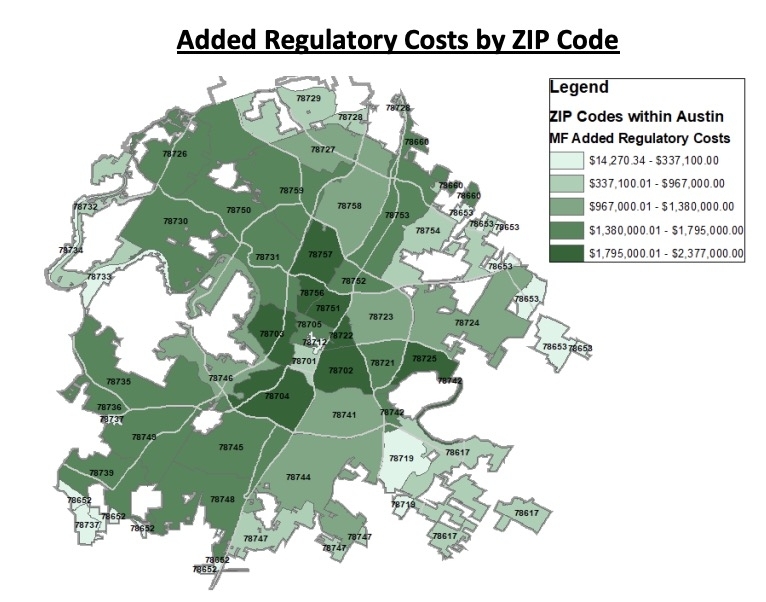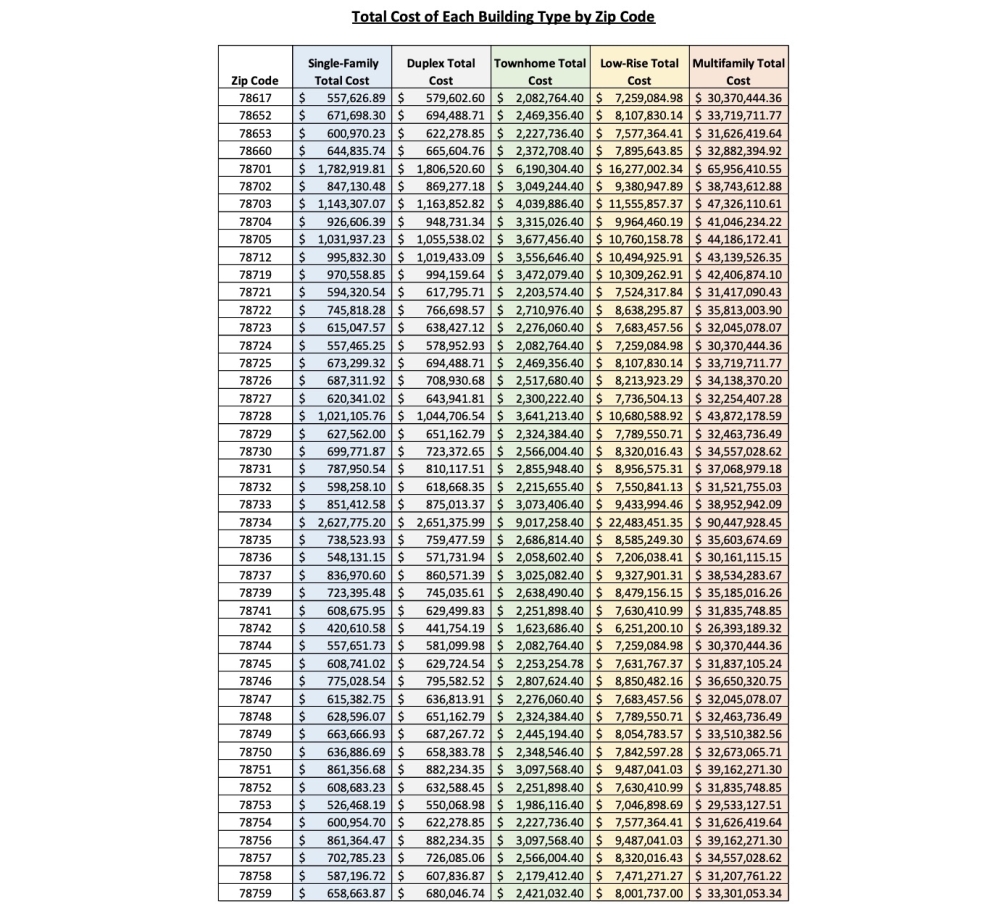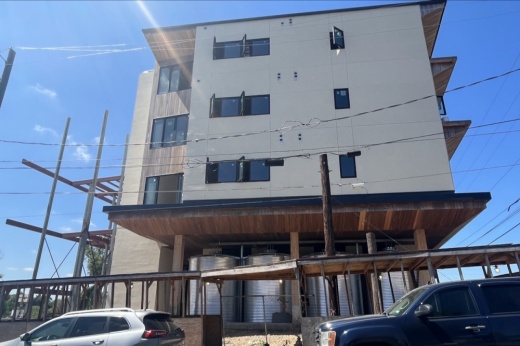The new analyses arrive this year with a City Council that's been vocally in favor of updating land-use regulations to sanction more types of development across town, to split public reception.
Among analysts' top findings were Austin's standout costs compared to other cities, as well as the competitive local cost of multifamily versus single-family development and the elevated price tag of construction on the west side. Those and other takeaways from the reports echo sentiments many developers, housing advocates and city officials have shared for years—and align with policy changes that are already in the works.
The big picture
A previous City Council request to examine the bottom line of local housing development has led to a comprehensive accounting of those costs and related proposals for city leaders and staffers to consider.
The studies were completed last year by The University of Texas graduate students. Now, takeaways could be used to guide internal process improvements and bring more housing online at a lower price.
“It is very valuable information, and it is definitely impacting our work," said Jamey May, Austin's housing and community development officer. "This information, coupled with previous reports, ... we take all of that information and use it to better allocate the funds to develop the city in a more responsible manner."
The setup
In late 2021, Council Member Natasha Harper-Madison asked for an in-depth review of how much it costs to bring housing online in Austin.
“The original intent was to really try to quantify some of the things that we hear about every day—the cost of housing, which parts of town are harder or easier to build housing in," said Mayor Pro Tem Paige Ellis, a cosponsor of Harper-Madison's request. "Really trying to make sure we had the numbers and the dollars and cents as opposed to anecdotes and a general feeling that things were too expensive."
In collaboration with city staff, UT researchers compiled two reports on the topic last year: one centered on housing development and the other with recommendations to cut related costs. The reports were published in July.
Following their release, Harper-Madison said the research proves housing costs were "designed to be more expensive and inaccessible" in specific parts of Austin. And looking forward, she said she hopes council can consider that imbalance during ongoing land-use and affordability debates.
"Until we can reduce the cost of development and reform our housing rules to allow more homes in every neighborhood, we are doomed to repeat the mistakes of our past," she said in a statement. "These reports are the ‘Big Bird’ canary in the coal mine for Austinites who refuse to acknowledge that every day, every month we wait—another Austinite faces eviction. Another family loses their home."
Top takeaways
At a high level, UT's team found buying land and construction are "unsurprisingly" the main factors behind the price of housing development in every corner of the city. In addition, they said city regulations are the cost driver with the most notable impact in Central and West Austin.
With land and material costs rising, they said the margins for housing development have slimmed, and any extra costs can now end up making or breaking a project.

Building off a citywide baseline, researchers put a price on the development of different housing types across Austin ZIP codes. From single-family homes to multifamily apartment complexes, overall expenses also added up most in Austin's urban core and farther to the west.

Despite significantly higher overall costs, analysts found apartments are the cheapest housing type to build per unit—by tens of thousands of dollars—but also most burdened by local regulations and rezoning expenses compared to standalone homes. By unit, single-family housing is by far the most expensive to construct.
"These results highlight both the [importance] of multifamily housing and the precarity of the multifamily development process," the report states. "Multifamily housing allows for more housing per square foot than low-intensity uses and is cheaper to build per unit. Both of these benefits are important as the city works to meet its Strategic Housing Blueprint goals."
The report also highlighted the delays and related costs that can mount as projects move through Austin's development reviews. Although the city has sought to speed up those processes for years, builders are still experiencing the effects of a slower system that can end up passing costs along to residents.
With those expenses in mind, analysts pointed to the opportunity cost of building in Austin versus other Texas cities where regulations and expenses can be lower. One developer interviewed by the UT team labeled that factor as a "cost to society" given Austin's shortage of attainable housing options.
“There was someone in [a stakeholder interview] that basically said, ‘It takes a year to get through Austin permits and only six months in Houston, so for every unit I could build in Austin I can build two in another city,'" Ellis said. "We want to make sure that people who can and want to build those two units can do that.”
To close out the first report, the UT team said the city could consider steps such as:
- Improving the accuracy of permit review tracking and standardizing those processes to make them more predictable
- Creating a "sunset commission" to identify outdated or adverse land development codes that could be cleared away
- Updating Austin's slate of neighborhood plans on a more regular basis; many have sat untouched since the early 2000s
The second phase of UT's reporting focused more on potential updates to address housing costs in the face of the affordability struggles that mounted over the past decade.
"In 2010, Austin was, by some accounts, considered to be one of the most affordable cities to live in America. A little over a decade later, it is now considered one of the least affordable metropolitan areas for homeownership in the country," the report said.
Researchers pointed to a flood of higher-income residents arriving in town along with the slow pace of pay increases versus housing costs as key contributors to unaffordability. They linked those trends with persistent gentrification—concentrated to the east—and a growing homeless population as well.
Building off the initial housing costs review and with those issues in mind, a UT team came up with several recommendations for Austin leaders to consider when focusing on housing policy. Those include:
- Lowering construction material and labor costs in the community, in part through workforce training
- Increasing Austin's housing supply and the variety of feasible housing types, potentially through cuts to single-family zoning and adding more accessory dwelling units, or ADUs
- Limiting regulatory constraints, such as compatibility standards and parking mandates
- Improving the efficiency of incentive programs that encourage affordable housing development, and considering combining the most popular initiatives
- Advocating for more support from state housing programs
“One thing that jumps out in the report is that, as with any report, it’s out of date as soon as you hit print. The actual cost of development has escalated rapidly in just the last year," he said. "But, what the report can show us is our initiatives and our policies are pointing in the right direction. We want housing throughout the city, not just isolated in one part of town. We want all types of housing for all types of residents."
What's next
According to May, requests for city support for income-restricted developments have shot up from as low as $2 million per project just a few years ago to well over eight figures today. Thanks to some of the factors outlined in the recent reports, Austin's housing strategy is accounting for those increases while moving to get enough development for lower-income residents out the door.
"It’s uncomfortable because we know that if we give $12 million to one development, five years ago we could have funded two entire developments with that same dollar. However, it’s not five years ago, so we need to adapt with the times," he said. "We want to make sure that every dollar that we’re putting into a development counts."
May also said it'll be important to focus on the findings and improved efficiency to meet citywide affordable housing goals, both in terms of overall production and getting projects underway in the more expensive parts of town.
While staff consider those issues, city officials continue to eye permitting improvements and land-use policy updates. Several high-profile items on those topics already passed this year or are in the works, and council members are set to receive an in-depth consultant report covering the development services department's operations late this month.
“I kind of love the juxtaposition of saying, ‘There’s already a lot that’s been started and initiated, but we’ve got to get through it all,'" Ellis said. "Meanwhile, we’re constantly coming up with other ideas to make things better and just trying to balance the workload of staff and the council offices to try to follow up on these initiatives.”
Harper-Madison also noted that many recommendations from the UT researchers align with recent City Council action with more updates likely to come in the near future.
"I am proud of the work my council colleagues and I have accomplished in the first six months of this year," Harper-Madison said. "We have initiated most of the critical recommendations from the Housing Cost Analysis: eliminating parking minimums, reducing compatibility, decreasing minimum lot sizes and revamping our SMART housing policies."
She also invited interested Austinites to attend council's meetings through the fall, including its Housing and Planning Committee sessions, for more discussion of the new reports and potential next steps.





